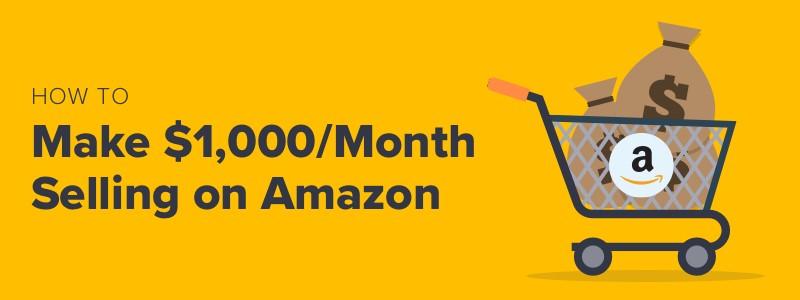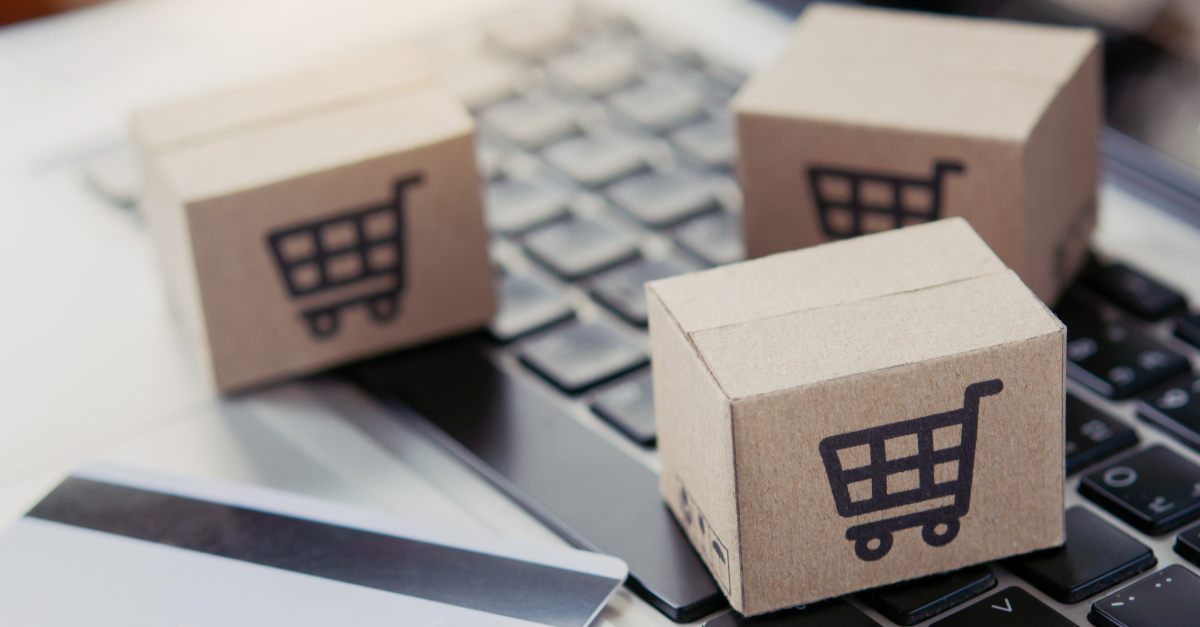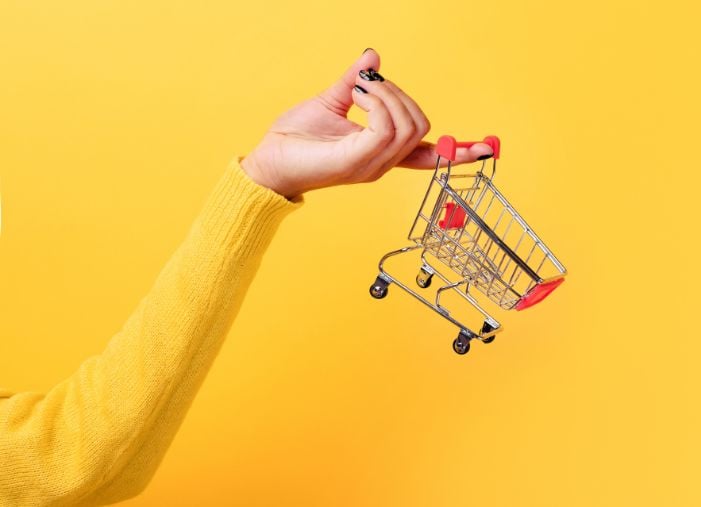When you think about making an online purchase, your brain might be hardwired now to go right to Amazon. If that’s true, you’re not alone.
There are over 310 million active users on Amazon, and 100 million of them are Prime members—that’s a lot of two-day shipping.
Amazon is an ecommerce behemoth, and the company is quickly moving into other markets like streaming services, grocery and food delivery, music, video games, fashion, and even healthcare. This vertical integration is making even it harder for smaller businesses to stay competitive.

As they say: If you can’t beat ’em, join ’em. And there are plenty of ecommerce brands making a lot of money by selling on Amazon. While running your own ecommerce site provides more control over branding and profit margin, you can’t ignore Amazon—in fact, you might be better off joining.
If you’re looking to increase profits from your ecommerce business, it’s time to start selling on Amazon! Ready to get your feet wet? Wondering how to make $1,000 per month selling on Amazon? Before we get into how to accomplish that, let’s review some basics to see if selling on Amazon is the right opportunity for you.
Contents
- How to sell on Amazon (for beginners)
- How much can I earn by selling on Amazon?
- How to make money selling on Amazon
Before you get started with that $1,000/month goal, you need to get set up to sell your products on Amazon. There are two options for ecommerce vendors: selling on Amazon with FBA or selling on Amazon directly. Here’s how to choose the best option for your business.
Amazon is a global leader in online selling because of its cutting-edge, worldwide order fulfillment networks. If you sign up for Fulfillment by Amazon (FBA), you can store your products in their centers and scale your business reach by using FBA to pick, pack, ship, and provide customer service for your products.
Think about it: If you’re just getting started in ecommerce, you need to take the time to market your business with digital ads, SEO, content, and PR. By selling on Amazon through FBA, you at least get to remove inventory management, shipping, the signature process, and returns from your plate.
Plus, Amazon’s customer service via email, phone, and live chat tools can save you from hiring employees to handle complaints and returns. Customer service and returns for any orders your customers place are handled directly by FBA and their knowledge base software database. This saves you time and frustration so you can focus on selling on Amazon to the best of your ability.
And there are more benefits:
- You can use Amazon FBA to quickly grow your business since its fulfillment centers have been designed with wide-ranging inventory in mind.
- There is no minimum number of products you must send in order to participate in this program.
- Storing your products in the Amazon fulfillment centers is cost-effective.
- You basically pay as you go.
- Amazon charges for storage space and the orders it fulfills for your customers. Shipping costs are included in your fees.
The Amazon fulfillment center that stores your products will be assigned to you. You can box up a variety of items and ship them to the assigned warehouse. You are only responsible to package them correctly and send them to the fulfillment center.
Be sure to pay attention to where Amazon assigns items to be sent, though. For example, you may be sending in 20 copies of a cookbook, but they assign 10 to one center and 10 to another.
If these benefits sound worth it for your business, you’ll just need to sign up for an FBA account. Here are three main steps to get started:
- Create your product listings—add them in one at a time or in bulk with Amazon’s API.
- Prep your products and make sure they are ready to sell and ship to Amazon. They provide a page of helpful products you may need including packing tape, barcode scanners, measuring tools, and more.
- Ship your products directly to Amazon. They can provide discounted carrier rates with their partnership programs and allow you to track your order to the warehouse.
Once your products are listed and you generate sales, Amazon takes their orders and provides Prime members with free two-day shipping from their huge network of warehouses.
Now, you’re all set to start selling on Amazon though FBA! Amazon will fulfill your orders, and you can focus on driving online sales.
Selling on Amazon directly is similar to selling your products on Etsy or eBay. Even as a side business, you can start selling on Amazon for $39.99 per month plus additional selling fees. The registration process is simple.
- Decide what you want to sell.
- Choose a selling plan.
- Register online.

The four-step setup process after registration is user-friendly and similar to Amazon FBA:
- List your products in the Amazon Marketplace.
- Sell items to customers.
- Ship the products to customers.
- Get paid directly by Amazon into your bank account.
You’re responsible for listing your product, managing the inventory, and shipping it to customers. When selling on Amazon directly, you have more access to contact customers to request a review or handle issues that may arise before the customer posts a negative review. This is important because you don’t want an issue with your customer experience strategy to negatively impact your brand.
When you’re selling on Amazon, really anything is possible: You could be making $9 or $9 million. The answer varies.
Ultimately, the amount of money you can earn by selling on Amazon is directly correlated to the uniqueness of your products. You need to sell your own branded products with high margins (+50% to 66%). That way, your marketing efforts can afford a higher customer acquisition cost (CAC), and you’re making more for every sale (how to lower your customer acquisition cost here!).
Today more than ever, ecommerce content and storytelling drive brand loyalty. Focus on maintaining your brand image on Amazon so that your products are seen as reputable, high-quality goods from a company that consumers know and trust.
If you’re a seller with a large inventory of high-ranking products with high margins and good reviews, you will be set up for success. But just like any online business, it all comes down to how well you can choose your products and market yourself.
After you decide whether you want to ship products directly to customers or use the FBA system, you can start focus on building a well-trusted, well-reviewed brand on Amazon. The process of selling on Amazon begins when you grow your inventory and start listing products for sale in the Amazon Marketplace. The process of making money on Amazon starts with these four steps.
Here’s how make $1,000/month selling on Amazon.
1. Choose your product niche
It’s important to have a strategy for choosing your product niche. When you find the right niche, it can potentially become a gold mine for you in your Amazon selling business. Choosing one product niche can help you better track which products are selling and which are not.
When you find a great niche, you can also sell online without a huge competitive market stealing customers away from you. However, this process starts with an objective analysis of the product niche, whether that’s matcha tea or minimalist watches.
Search for your product on Google Shopping to understand how many other brands are selling similar items. Check out the minimum advertised price (MAP) pricing. If you are going to have to compete against 25 other large retailers, the market may be too saturated to enter.
Choosing your product niche and sales funnel also involves understanding your customer persona Seasonality will also play a role, as products only in demand during the holidays, or specific times of the year require a different approach than year-round, evergreen products.

A niche like swimming pool basketball toys, for instance.
Ultimately, you should sell high-end, branded items (that only you sell) with high margins and low product weight.
2. Price your items to sell
If you want your items to sell, you need to price them accordingly. When you price your products higher than your competition, it can kill both your Amazon venture and any trust with your customers. 91% of customers buy from trusted branding, so you need to build this customer trust on Amazon, too.
Once you build trust and start generating sales, you may see that Amazon starts to promote your products. Amazon automatically promotes other products in the section on the product detail page under “Customers who bought this item also bought.”

Setting the price for your product involves the following strategy:
- Have a profit margin over 50% to 66%.
- Price your item between MAP and MSRP pricing.
- Know your cost of goods sold (COGS).
- Remember to count additional fees, such as the Amazon commission on sales, Amazon FBA fees, customer return fees, fees for returns that you have incurred, overhead costs, packing and shipping costs, and any category-specific costs. For example, vendors selling apparel on Amazon will incur category-specific costs due to the high rate of customer returns for these items.
Finally, search for other Amazon products similar to yours. Use the same three keywords that you used for your description page and search for other products to see what appears.
You’ll want to stand out from this list with strong pricing, high quality imagery, and a highly clickable product title.
3. Improve product page ranking
Ask yourself if your price is comparable to your competitors’. You need to have a competitive price and unique product descriptions so that your product ends up on page one of the Amazon search results. Page one results mean that customers are seeing your products first, which will increase the probability of a sale.
You can get your products to page one results when you invest in Amazon SEO strategies like the following:
- Relevant product title
- Your Amazon backend keywords
- Your product’s price and conversion rate
- Your Amazon reviews
- Your product’s price
Making sure you have high-quality product photos is also important, which is why I recommend using free photo editing tools to improve your image quality.

Research your competition to continually generate sales from high rankings. Tweak your product title to generate a high click-through rate so that you can continually generate organic sales.
Remember that ecommerce promotions often follow retail holidays like Black Friday, Cyber Monday, and even other more general promotions like winter clearance or fall sales. Promotional periods are high sales periods, which is another reason your profit margin should be high.
Most often, sellers choose to deviate from a stable price in the following instances:
- Launching new products
- Cross-selling
- Selling stock clearance items
- Sales like Black Friday or Cyber Monday
However, lowering your price for these reasons means that you usually lower them to near break-even level—sometimes even lowering them below the profitability level. This is not recommended for normal pricing, so you have to deeply understand your profit margin and cost of goods sold (COGS).
Remember, your return on ad spend for any marketing should always be 3:1. So if you spend $100 on marketing, you need to generate $300 in sales to maintain profitability.
4. Add detailed product information
Products can be listed in the Amazon Marketplace catalog one at a time. However, if you obtain a professional selling subscription, you have the option to add larger groups of products through the bulk tools. If the products are not yet listed on Amazon, you can identify the UPC/EAN and SKU.
Then, you describe the attributes of the product, such as a title and detailed description information. If the product is already listed on Amazon, you need to identify the number of products you have to sell, list the condition, and the shipping options.
If you want to make a lot of money on Amazon, simply describing the basics of your product is not good enough. Amazon keywords are everything for sellers. A good majority of sales on Amazon occur through organic searches for products. If you haven’t optimized your product descriptions and checked your grammar and SEO, you can lose out on traffic to your products and sales.

Now, go make money by selling on Amazon!
Making a profit by selling on Amazon is possible if you think smart, implement a well-planned strategy, and effectively market your business.
Identify your process, (whether you’re shipping products yourself or using FBA), engage in Amazon SEO, optimize your product pages, market your brand effectively, and price your items to sell.
Because remember, even if you can’t beat ’em, you can join ’em—and make $1,000 each month selling on ’em if you follow these steps.







